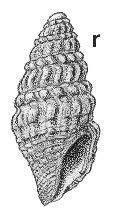
Revised descriptions of New Zealand Cenozoic Mollusca from Beu and Maxwell (1990)

 | Revised descriptions of New Zealand Cenozoic Mollusca from Beu and Maxwell (1990) | 
|
  (Pl. 37r): holotype, left bank of Awatere River upstream from Seddon rail bridge, Marlborough, coll. J. A. Thomson, 1912; Waipipian (TM6827, GNS) |
Beu & Maxwell (1990): Chapter 14; p. 302; pl. 37 r.
Synonymy: Awateria streptophora Suter 1917, p. 57
Type species of Awateria Suter, 1917
Classification: Conidae: Borsoniinae? (not included by Puillandre et al. 2008)
Description: Small for family (10-12 mm high), relatively short and stout, with moderately tall spire (1.5 times height of aperture and canal) and short anterior canal; very coarsely sculptured. Outer surface translucent and pale brown when well preserved; apparently calcific. Sculpture of massive, wide, coarsely axially beaded subsutural fold, followed below by narrow, strongly concave sutural ramp (a spiral constriction) corresponding to apex of anal sinus, followed by very wide, raised, peripheral spiral band, followed in turn by 1 spiral cord on spire whorls and about 10 cords of anteriorly decreasing width and spacing on last whorl and base; all crossed by prominent, closely spaced axial costae, about 16 per whorl, forming prominent nodules at sculptural intersections. Aperture simple, with short, widely open canal; outer lip with wide, shallow, U-shaped sinus occupying sutural ramp. Protoconch unknown.
Comparison: The typical Pliocene species of Awateria are all closely similar (A. streptophora; A. evanida, from the type locality of A. streptophora, and from Lake Grassmere; and A. retiolata (= A. mollyae) from Palliser Bay, southern Wairarapa, Mangapanian). A. evanida and A. retiolata are similar, differing in the taller form and slightly narrower cords of A. retiolata; both differ from A. streptophora in their narrower subsutural cord and narrower spiral cords. Several Miocene species from bathyal siltstone in Wairarapa and northern Hawke's Bay appear to be congeneric (see also Maxwell 1988a, p. 67). Most typical Pliocene species occur in bathyal siltstone (deposited in 400-1000 m) with Aeneator (Ellicea) and Falsilunatia; a good bathyal index. B. A. Marshall (pers. comm. in Maxwell (1988a, p. 67)) recorded that "Vexitomina" optabilis (Murdoch and Suter 1906, p. 283, pl. 21, fig. 9) is very similar to, if not conspecific with, A. retiolata, and is a Recent species of Awateria; A. optabilis was described from 200 m, off Great Barrier Island. Suter (1917) gave a detailed protoconch description, but the apex is corroded in all Pliocene Awateria material we have examined; Suter was evidently describing the decorticated apical remnant.
Distribution: Waipipian (-Mangapanian?); left bank of Awatere River upstream from Seddon rail bridge, Marlborough, Waipipian (type); uncommon in deep-water siltstone in the Awatere Valley and in the Greta Stream-Motunau Beach area, North Canterbury.
Cite this publication as: "A.G. Beu and J.I. Raine (2009). Revised
descriptions of New Zealand Cenozoic Mollusca from Beu and Maxwell (1990). GNS
Science miscellaneous series no. 27."
© GNS Science, 2009
ISBN
978-0-478-19705-1
ISSN 1177-2441
(Included with a PDF facsimile file
copy of New Zealand Geological Survey Paleontological Bulletin 58 in CD version
from: Publications Officer, GNS Science, P.O. Box 30368 Lower Hutt, New
Zealand)